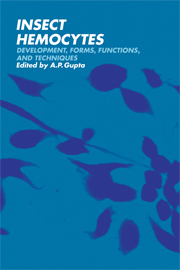Book contents
- Frontmatter
- Contents
- Preface
- List of contributors
- Part I Development and differentiation
- Part II Forms and structure
- Part III Functions
- 11 Hemocytes and growth in insects
- 12 Hemocytes and connective tissue: a critical assessment
- 13 Role of hemocytes in defense against biological agents
- 14 Cellular and humoral responses to toxic substances
- 15 Biochemical and ultrastructural aspects of synthesis, storage, and secretion in hemocytes
- 16 Changes in hemocyte populations
- Part IV Techniques
- Indexes
13 - Role of hemocytes in defense against biological agents
Published online by Cambridge University Press: 04 August 2010
- Frontmatter
- Contents
- Preface
- List of contributors
- Part I Development and differentiation
- Part II Forms and structure
- Part III Functions
- 11 Hemocytes and growth in insects
- 12 Hemocytes and connective tissue: a critical assessment
- 13 Role of hemocytes in defense against biological agents
- 14 Cellular and humoral responses to toxic substances
- 15 Biochemical and ultrastructural aspects of synthesis, storage, and secretion in hemocytes
- 16 Changes in hemocyte populations
- Part IV Techniques
- Indexes
Summary
Introduction
Over three-quarters of animal species known to man are insects, and it has been estimated that there may be as many as 3 million different species (Williams, 1960) living in almost every habitat on earth. During their evolution and colonization of the terrestrial niches, the insects became open to attack from a formidable array of predators, parasites, parasitoids, and microorganisms, and recent research indicates that they have effective defense mechanisms capable of resisting, containing, and even eliminating many would-be invaders (Whitcomb et al., 1974). These defenses include the physicochemical barriers formed by the tough outer cuticle and gut and the internal humoral and cellular defense mechanisms. The cellular defenses are mainly mediated by the hemocytes and include the processes of phagocytosis, nodule formation, encapsulation, and hemolymph coagulation (Salt, 1970), which together form the main subject of this review. However, because most of our knowledge of insect defense mechanisms has been derived from laboratory investigations and little is known about the effectiveness of these defenses in the field, brief consideration must also be given to the natural biological control agents themselves, their mode of entry into the host, and the type of host response most likely to be elicited. This approach, it is hoped, will give the results of laboratory experiments a new dimension and prompt future investigators to accord more consideration to the defense mechanisms of natural insect populations.
Diseases of insects
These are produced by the pathogenic viruses, bacteria, fungi, protozoa, rickettsiae, and nematodes. In addition, predatory and parasitic insects are of enormous significance in controlling vast numbers of pest and potentially injurious insect species (van den Bosch and Messenger, 1973) (see also Chapter 16).
- Type
- Chapter
- Information
- Insect HemocytesDevelopment, Forms, Functions and Techniques, pp. 331 - 414Publisher: Cambridge University PressPrint publication year: 1979
- 91
- Cited by

